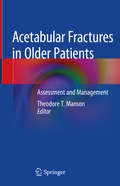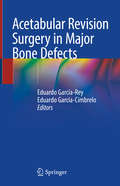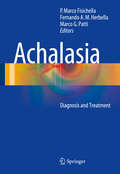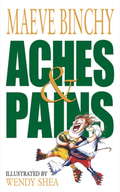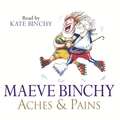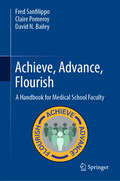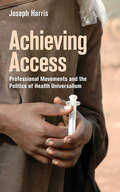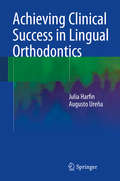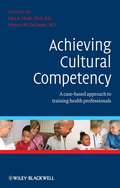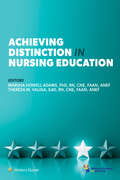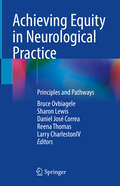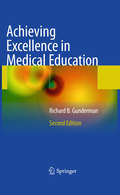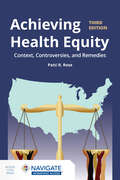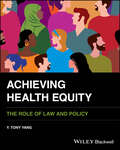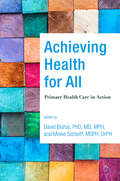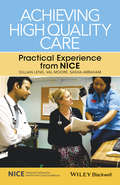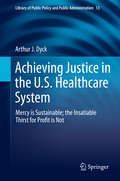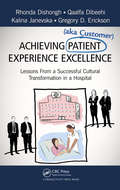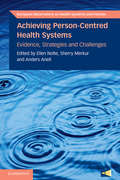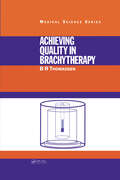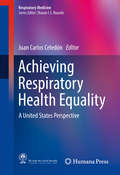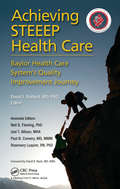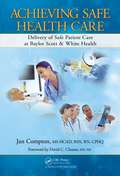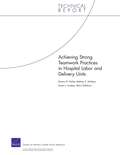- Table View
- List View
Acetabular Fractures in Older Patients: Assessment and Management
by Theodore T. MansonAcetabular fractures in older adults are increasing in frequency and present unique challenges to the surgeons charged with their treatment. This text provides the clinician tools for deciding who is an operative candidate and reviews in detail the various surgical treatments available for management. Opening chapters discuss the scope of the problem, the functional status of older patients and the risks involved with any surgical approach. After a chapter discussing non-operative approaches to acetabular fractures, the remaining chapters present the various surgical techniques and include a critical assessment of the outcomes of these treatment choices. ORIF techniques for posterior and anterior wall and column fractures are followed by percutaneous treatment and total hip arthroplasty, both alone and in combination with ORIF. Presenting the most current strategies for these increasingly common injuries, Acetabular Fractures in Older Patients is an excellent resource for all orthopedic and trauma surgeons.
Acetabular Revision Surgery in Major Bone Defects
by Eduardo García-Rey Eduardo García-CimbreloThis book reviews the most important issues related to acetabular revision hip surgery and assesses the different management procedures that are currently used in light of the challenging major defects. Since the 1970s there has been a continual rise in the annual number of total hip arthroplasty (THA) procedures which has increased the demand for revision surgeries. Most revisions operations of the hip are the result of acetabular problems and early failures are usually related to acetabular bone defects in complex primary THAs. Long-term failures are mostly due to wear debris and osteolysis-related problems and both types of complications are presented throughout the book. Surgeons with a special interest in hip reconstruction surgery will find this book to be an essential resource for successfully dealing with highly complex revision procedures.
Achalasia: Diagnosis and Treatment
by P. Marco Fisichella Marco G. Patti Fernando A. M. HerbellaEach chapter describes a very specific aspect of Achalasia by its known expert. Current diagnostic and management strategies of Achalasia, as well as the simplified operative approaches with relevant technical considerations, are outlined for the specific target audience. The treatment of Achalasia is complex and usually performed in specialized tertiary-care centres. The Editors' main goal is to render this disease more understandable and accessible to residents, fellows, and specialists in both the surgical disciplines (general surgery and thoracic surgery) and in gastroenterology.
Aches & Pains
by Maeve BinchyA brilliantly funny guide to the trials and tribulations of hospitals and convalescence - from No. 1 bestselling author Maeve Binchy.Get the feel-better factor from Maeve Binchy as she teams up with artist Wendy Shea to bring us ACHES & PAINS. This gem of a book includes:Five things you can say to annoy the patient in the next bedHow to put on elastic stockingsSix ways to make non-alcoholic drinks bearableHow to be the perfect hospital visitorUnusual but essential things for your medicine cupboardFilled with the fun, warmth and wisdom for which Maeve Binchy is famous, ACHES & PAINS is the perfect alternative to a Get Well card.
Aches & Pains
by Maeve BinchyA brilliantly funny guide to the trials and tribulations of hospitals and convalescence - from No. 1 bestselling author Maeve Binchy.Get the feel-better factor from Maeve Binchy as she teams up with artist Wendy Shea to bring us ACHES & PAINS. This gem of a book includes:Five things you can say to annoy the patient in the next bedHow to put on elastic stockingsSix ways to make non-alcoholic drinks bearableHow to be the perfect hospital visitorUnusual but essential things for your medicine cupboardFilled with the fun, warmth and wisdom for which Maeve Binchy is famous, ACHES & PAINS is the perfect alternative to a Get Well card.
Aches & Pains
by Maeve BinchyGet the feel-better factor from Maeve Binchy as she teams up with artist Wendy Shea to bring us ACHES & PAINS. This gem of a book includes:Five things you can say to annoy the patient in the next bedHow to put on elastic stockingsSix ways to make non-alcoholic drinks bearableHow to be the perfect hospital visitorUnusual but essential things for your medicine cupboardFilled with fun, warmth and wisdom, for which Maeve Binchy is famous, ACHES & PAINS is the perfect alternative to a Get Well card.Read by Kate Binchy(p) 2002 Orion Publishing Group
Achieve, Advance, Flourish: A Handbook for Medical School Faculty
by Claire Pomeroy Fred Sanfilippo David N. BaileyThis informative reference will help full-time, part-time, and affiliated medical school faculty navigate the inspiring, evolving, and complex challenges of achieving success in their academic positions. The easy-to-read format poses frequently asked questions and provides answers that convey valuable insights, useful references, and practical advice. Designed for use by faculty at all stages of their career, this handbook addresses issues about selecting a career in academia, starting out in one&’s first position, advancing successfully, skill development, transitioning to other positions, and retirement. It provides guidance about the development of the personal and professional skills needed to thrive in these roles, and summarizes advice about creating programs, collaborations, and successful teams. Helpful tips about career planning and successfully advancing in the promotions and tenure process are enumerated. Recognizing that most faculty will have to face challenges at some point in their career, this handbook also outlines useful recommendations for dealing with difficult colleagues, crisis management, and work-personal life balance. Given the rapid evolution of knowledge and organizations in healthcare, science, and medicine, this reference emphasizes the importance of adapting to change and embracing the opportunities for innovation and future impact. Highlighting both the increasing challenges of these roles and the inspiring opportunities available through these careers, the authors provide comprehensive information to help medical school faculty achieve impact in their disciplines, advance their careers, and flourish both personally and professionally.
Achieving Access: Professional Movements and the Politics of Health Universalism (The Culture and Politics of Health Care Work)
by Joseph HarrisAt a time when the world’s wealthiest nations struggle to make health care and medicine available to everyone, why do resource-constrained countries make costly commitments to universal health coverage and AIDS treatment after transitioning to democracy? Joseph Harris explores the dynamics that made landmark policies possible in Thailand and Brazil but which have led to prolonged struggle and contestation in South Africa. Drawing on firsthand accounts of the people wrestling with these issues, Achieving Access documents efforts to institutionalize universal healthcare and expand access to life-saving medicines in three major industrializing countries. In comparing two separate but related policy areas, Harris finds that democratization empowers elite professionals, such as doctors and lawyers, to advocate for universal health care and treatment for AIDS. Harris’s analysis is situated at the intersection of sociology, political science, and public health and will speak to scholars with interests in health policy, comparative politics, social policy, and democracy in the developing world. In light of the growing interest in health insurance generated by implementation of the Affordable Care Act (as well as the coming changes poised to be made to it), Achieving Access will also be useful to policymakers in developing countries and officials working on health policy in the United States.
Achieving Clinical Success in Lingual Orthodontics
by Julia Harfin Augusto UreñaThis book is designed to meet the needs of all orthodontists interested in treating children, adolescents, and/or adults with brackets placed on the palatal and lingual surfaces of the teeth. It explains how to achieve excellent results, comparable to those obtained with labial brackets, by means of techniques performed entirely within the dental office and avoiding use of expensive outside laboratories. The book is divided into three parts. The first is devoted to biomechanics, considering each type of malocclusion and describing how to prepare the arches optimally. This is not a theoretical section; rather it covers aspects acknowledged to be of prime practical importance by students and doctors. The second part explains how to treat the most common malocclusions, with step-by-step descriptions of techniques used in everyday clinical practice. The concluding part of the book describes finishing procedures to enhance aesthetics and discusses long-term results.
Achieving Cultural Competency
by Lisa Hark Horace DelisserAchieving Cultural Competency: A Case-Based Approach to Training Health Professionals provides the necessary tools to meet the ever-growing need for culturally competent practitioners and trainees. Twenty-five self-study cases cover a variety of medical topics, including cardiovascular, pulmonary, neurology, oncology, hematology, immunology, and pediatric disorders. Actual scenarios that occurred in clinical settings help the user gain direct insight into the realities of practice today. Cultural factors covered within the cases include cultural diversity plus gender, language, folk beliefs, socioeconomic status, religion, and sexual orientation.This book is an approved CME-certifying activity to meet physicians' cultural competency state requirements.Get 25 pre-approved self-study American Dietetic Association credits at no additional charge when you purchase the book. Email hark@lisahark.com for further instructions.
Achieving Distinction in Nursing Education (NLN)
by Marsha Adams Theresa ValigaAchieving Distinction in Nursing Education, based on the National League for Nursing (NLN) Hallmarks of Excellence in Nursing Education Model, provides in-depth discussions of the eight core elements for superior nursing education: Engaged Students Diverse, Well-Prepared Faculty Culture of Continuous Quality Improvement Innovative, Evidence-Based Curriculum Innovative, Evidence-Based Approaches to Facilitate and Evaluate Learning Resources to Support Program Goal Attainment Commitment to Pedagogical Scholarship Effective Institutional and Professional Leadership This book also presents accompanying indicators to assist nurse educators in assessing the strengths of their programs and identifying areas for further development. Featuring contributions from 15 recognized experts and thought leaders in nursing education, administration, and research, this innovative resource is designed to challenge and inspire you to advance toward unparalleled outcomes for your career and your institution.
Achieving Equity in Neurological Practice: Principles and Pathways
by Bruce Ovbiagele Sharon Lewis Daniel José Correa Reena Thomas Larry Charleston IvThe recent high-profile murders of George Floyd, and other African American individuals, along with the prevailing coronavirus disease (COVID-19) pandemic have reinforced the notion that certain marginalized populations have worse health outcomes than other populations, likely due to unequal and unjust policies and practices. Neurological processes and prognoses frequently vary by sex/gender, race/ethnicity, socioeconomic status, and geographic location. In particular, individuals of lower socioeconomic status and from minority racial and ethnic backgrounds have worse neurological health and often receive a lower standard of neurological care. These inequities in neurological outcomes are attributed to wider societal social influences, which impact how people live and how neurology is practiced. Published evidence suggests that healthcare providers and the healthcare system contribute to inequities in neurological care for vulnerable and underserved populations. However, educating neurology care providers about these issues and training them to provide equitable care for these patients can potentially improve neurology care access, delivery, and outcomes. In this book we provide the theoretical background, scientific evidence, and experiential knowledge warranted to properly care for vulnerable, underserved patients with neurological diseases at the levels of the provider and system. This book examines the root causes of neurological health inequities across a broad range of topics and offers possible solutions for achieving neurological health equity. Initial chapters help to frame the overall issue of neurological health equity. Subsequent chapters evaluate neurological health equity from the clinical practice standpoint, with a focus on select populations and subspecialty care delivery settings. Lastly, we discuss the bigger picture with regard to the pipeline of practitioners and purview of policy makers. This text is relevant for neurology residents and fellows, multidisciplinary neurological care practitioners (neurologists, neurosurgeons, advanced practice providers, hospitalists, emergency physicians, critical care physicians, pharmacists, and allied health personnel), and public health researchers and health policy makers. The book is divided into three sections: Principles, Neurological Conditions, and Priorities. The first section establishes the framework and explains various key terminologies and concepts, which undergird the care of vulnerable and undeserved patient populations. The second section, Neurological Conditions, covers key neurological diseases by sub-specialty describing published evidence of care and outcome disparities, gaps in knowledge, practical techniques for bridging these disparities on provider and system levels. The third section, Priorities, identifies important areas of focus and improvement targeting trainees, researchers, community partners, stakeholder organizations and policy makers, which would be crucial for implementing sustained societal-level enhancements in the neurological health of these vulnerable populations.
Achieving Excellence in Medical Education: Second Edition
by Richard B. GundermanA goldmine of theoretical insights and practical suggestions, Achieving Excellence in Medical Education, Second Edition explores the essential question facing medical educators and learners today: What is our vision of educational excellence, and what can we do to enhance our performance? Among the topics explored within this updated, engaging, informative, and thought-provoking text are: * Education's position as a priority of medical schools * Seminal educational insights from non-medical educators * Best practices of outstanding educators and learners * Promises and pitfalls of new educational technologies * Key resources for promoting excellence in medical education * Medical education's role in preparing future leaders * Leadership roles for medical schools in universities and society Reviews of the first edition: "This is an eloquent, quotable, and inspirational book that provides a template for "Achieving Excellence in Medical Education." - Journal of the American Medical Association "Gunderman is an accomplished educator, well known as a thoughtful and provocative teacher. . . I recommend his book to department chairs, clerkship and residency program directors, and education professionals who are shaping the future of medical education." - New England Journal of Medicine
Achieving Health Equity: Context, Controversies, and Remedies
by Patti R. RoseRenamed as Achieving Health Equity: Context, Controversies, and Remedies, Patti Rose's third edition maintains a distinct focus on social justice issues associated with health disparities. With an emphasis on solutions, this edition, like its predecessor, centers on racial and ethnic emerging majorities, acknowledging the persistence of health disparities while providing actionable insights on why they exist and how to address them. By providing this solution-oriented approach, the book aims to engage and guide students, academics, communities, health professionals, and others in contributing to resolving the problems linked to health disparities.Updated to include the latest demographic data, the Third Edition offers:Four new chapters that provide an expanded focus on emerging (racial and ethnic) majority groups and health disparities and include: Black/African American; American Indian or Alaska Native; Asian/Pacific Islander; and Hispanic.Updated information pertaining to the health disparities of the elderly, women, urban communities, suburban communities, and rural communities.Expanded insights into current DEI issues, both politically and otherwise, as well as the potential impact of educational changes on health literacy. Focus on Healthy People 2030 with an emphasis on health equity, disparities, and solutions. Ideal for courses in Health Equity, Health Disparities, and/or any course focusing on the health of the elderly, women, children, racial and ethnic emerging majorities, and/or social injustice. © 2026 | 300 pages
Achieving Health Equity: The Role of Law and Policy
by Y. Tony YangUnveiling the Path to Health Equity: A Transformative Guide to Law and Policy Achieving Health Equity: The Role of Law and Policy offers a groundbreaking exploration of how legal and policy frameworks shape health outcomes for marginalized populations, with a particular focus on racial minorities in the United States. This comprehensive guide dissects the complex interplay of factors determining health: 20% healthcare, 30% health behaviors, 40% social and economic factors, and 10% physical environment. Amid the backdrop of the COVID-19 pandemic and a national reckoning on racism, this timely work provides an urgent call to action and a practical roadmap for transformative change. It examines how laws and policies across sectors intersect to perpetuate or dismantle health inequities, offering concrete strategies for reform. Key features include: An ecosystem approach exploring four critical domains: healthcare access and quality, health behaviors, social and economic factors, and physical environment Analysis of emerging issues such as addressing the impact of climate change on health disparities, strategies for mitigating algorithmic bias in healthcare AI, and promoting equity in organ transplantation and clinical trials Examination of cross-cutting themes like community engagement, civil rights protections, and data disaggregation to guide targeted interventions Case studies and policy tools for dismantling structural drivers of health inequity Written in accessible language without sacrificing depth, this book illuminates complex concepts through relatable examples. It serves as an invaluable resource for a diverse audience including health system administrators implementing diversity, equity, and inclusion initiatives, public health officials and policymakers, legal professionals and advocates, researchers and students in health-related fields, community organizers and racial justice activists. Achieving Health Equity provides a comprehensive blueprint for leveraging law and policy to build a more just, equitable, and healthy future for all.
Achieving Health for All: Primary Health Care in Action
by David Bishai, PhD, MD, MPH and Meike Schleiff, MSPH, DrPHHow did seven low- and middle-income countries, inspired by the landmark Alma-Ata Declaration, dramatically improve citizen health by focusing on primary health care?The Alma-Ata Declaration of 1978 marked a potential turning point in global health, signaling a commitment to primary health care that could have improved the safety of air, food, water, roads, homes, and workplaces in all 180 countries that signed it. Unfortunately, progress in many countries stalled in the 1980s. The declaration was, however, embraced by a number of countries, where its implementation led to substantial improvement in citizen health. Achieving Health for All reveals how, inspired by Alma-Ata, the governments of seven countries executed comprehensive primary health care systems, deploying new cadres of community-based health workers to bring relevant services to ordinary households. Drawing on a set of narrative case studies from Bangladesh, Indonesia, Ethiopia, Nepal, Ghana, Sri Lanka, and Vietnam,the book explains how a primary health care focus succeeded in improving population health. The book also conclusively demonstrates that comprehensive, multisector, community-controlled, and population-level primary health care is a viable strategy that, against the odds, has led to sustainable, scalable good health at lower cost. Bringing together a group of experts to analyze the forty-year legacy of the Alma-Ata Declaration, Achieving Health for All is a fascinating look at the work needed to transform nations from places that make people sick to places where they stay healthy. An inspiring array of lessons learned along the way shows how readers can make policies that support the health of all people.Contributors: Onaopemipo Abiodun, Vinya Ariyaratne, John Koku Awoonor-Williams, Kedar Prasad Baral, Ayaga A. Bawah, Pedro Más Bermejo, Fred N. Binka, David Bishai, Carolina Cardona, Dennis Carlson, Chala Tesfaye Chekagn, Hoang Khanh Chi, Svea Closser, Luc Barrière Constantin, Zufan Abera Damtew, Marlou de Rouw, Nadia Diamond-Smith, Philip Forth, Mignote Solomon Haile, Nguyen Thanh Huong, Taufique Joarder, Alice Kuan, Seblewengel Lemma, Sasmira Matta, Ahmed Moen, Rituu B. Nanda, Frank K. Nyonator, Ferdous Arfina Osman, Claudia Pereira, Henry B. Perry, James F. Phillips, Meike Schleiff, Melissa Sherry, Rita Thapa, Kebede Worku
Achieving High Quality Care
by Sasha Abraham Gillian Leng Val MooreDrawing on the experience of the National Institute for Health and Care Excellence (NICE), Achieving High Quality Care is a practical guide on how to recognise and implement high quality evidence and guidance.This new title provides an overview of the evidence behind successful initiatives designed to change practice and improve the quality of health care. It provides an overall picture of change management, from understanding the barriers to change to how these barriers can best be overcome. It presents a concise summary of the evidence for change, plus examples of specific initiatives drawn from experience of putting NICE guidance into practice.The book includes a wide range of examples of positive change - plus key practical points highlighted throughout the text - to help readers achieve improvements in patient care. Finally, it shows how to measure change, assess improvement to agreed standards and to manage the ongoing process of change towards improving health care.Achieving High Quality Care is a helpful guide for busy health care professionals wanting to improve services and patient care. It is relevant to everyone involved in the organisation and provision of quality health care, including clinicians and health care managers, who are trying to lead change and improve care through implementing evidence-based guidance.
Achieving Justice in the U.S. Healthcare System: Mercy is Sustainable; the Insatiable Thirst for Profit is Not (Library of Public Policy and Public Administration #13)
by Arthur J. DyckThis book focuses on justice and its demands in the way of providing people with medical care. Building on recent insights on the nature of moral perceptions and motivations from the neurosciences, it makes a case for the traditional medical ethic and examines its financial feasibility. The book starts out by giving an account of the concept of justice and tracing it back to the practices and tenets of Hippocrates and his followers, while taking into account findings from the neurosciences. Next, it considers whether the claim that it is just to limit medical care for everyone to some basic minimum is justifiable. The book then addresses finances and expenditures of the US health care system and shows that the growth of expenditures and the percentage of the gross national product spent on health care make for an unsustainable trajectory. In light of the question what should be changed, the book suggests that overdiagnosis and medicalizing normal behavior lead to harmful, costly and unnecessary interventions and are the result of unethical behavior on the part of the pharmaceutical industry and extensive ethical failures of the FDA. The book ends with suggestions about what can be done to put the U.S. health care system on the path to sustainability, better medical care, and compliance with the demands of justice.
Achieving Patient (aka Customer) Experience Excellence: Lessons From a Successful Cultural Transformation in a Hospital
by Rhonda Dishongh Qaalfa Dibeehi Kalina Janevska Gregory D. EricksonWritten by internationally acknowledged experts in the customer and patient experience movement, this book clearly outlines the principles and development phases of a great customer experience transformation. Using an engaging story, it allows readers to follow the journey of Community General, a healthcare organization that went from struggling to being nationally recognized for its performance and customer satisfaction. Demonstrating how Community General was able to achieve its cultural transformation, the book presents valuable lessons learned that can be applied across a wide range of industries.
Achieving Person-Centred Health Systems: Evidence, Strategies and Challenges (European Observatory on Health Systems and Policies)
by Ellen Nolte Sherry Merkur Anders AnellThe idea of person-centred health systems is widely advocated in political and policy declarations to better address health system challenges. A person-centred approach is advocated on political, ethical and instrumental grounds and believed to benefit service users, health professionals and the health system more broadly. However, there is continuing debate about the strategies that are available and effective to promote and implement 'person-centred' approaches. This book brings together the world's leading experts in the field to present the evidence base and analyse current challenges and issues. It examines 'person-centredness' from the different roles people take in health systems, as individual service users, care managers, taxpayers or active citizens. The evidence presented will not only provide invaluable policy advice to practitioners and policymakers working on the design and implementation of person-centred health systems but will also be an excellent resource for academics and graduate students researching health systems in Europe.
Achieving Quality in Brachytherapy (Series in Medical Physics and Biomedical Engineering)
by B.R. ThomadsenAchieving Quality in Brachytherapy addresses the main issues that often prevent correct delivery of brachytherapy treatment. The book explains how to set up a functional quality assurance program in brachytherapy and covers all the steps needed to undertake particular treatment plans, from the initial planning required to the detailed specification
Achieving Respiratory Health Equality: A United States Perspective (Respiratory Medicine)
by Juan Carlos CeledónIncluding comprehensive coverage of health disparities commonly encountered in pediatric and adult pulmonary, critical care, and sleep medicine, Achieving Respiratory Health Equality in the United States provides a definitive reference on this prominent issue. Expert authors explore questions such as: * What is the evidence that respiratory health disparities exist? * What do we know about the causes of the disparities? * What are the clinical implications? * What can be done to address the particular disparities and thus achieve health equality? Recognizing the magnitude of this problem, the American Thoracic Society (ATS) Executive Committee created a Health Equality Sub-Committee, with an initial mandate of defining respiratory health disparities and respiratory health equality in the United States. This book will follow the format of a workshop on respiratory health equality held before the 2015 ATS International Meeting and led by editor Juan Carlos Celed#65533;n. Written by the workshop presenters, this book focuses closely on major risk factors for health, specific respiratory diseases for which health disparities are known to occur, and potential approaches to eliminate such disparities. Achieving Respiratory Health Equality in the United States is a timely resource for researchers, clinicians, and public health practitioners in respiratory medicine.
Achieving STEEEP Health Care: Baylor Health Care System's Quality Improvement Journey
by David J. BallardWinner of a 2014 Shingo Research and Professional Publication Award!Reaching America‘s true potential to deliver and receive exceptional health care will require not only an immense and concerted effort, but a fundamental change of perspective from medical providers, government officials, industry leaders, and patients alike. The Institute of
Achieving Safe Health Care: Delivery of Safe Patient Care at Baylor Scott & White Health
by Jan ComptonWinner of a 2016 Shingo Research and Professional Publication Award!A recent article published in the Journal of Patient Safety estimated that more than 400,000 lives are lost each year due to preventable patient events in American hospitals. Preventable patient safety events are the third leading cause of death in the United States. While most hea
Achieving Strong Teamwork Practices in Hospital Labor and Delivery Units
by Donna O. Farley Susan L. Lovejoy Mary Salisbury Melony E. SorberoTo learn how hospital labor and delivery units can achieve effective and sustainable teamwork practices and how much such practices affect staff experiences and patient outcomes, RAND researchers studied five units as they implemented improvements in their teamwork practices over a one-year period. They identified some key factors required by any given strategy for teamwork improvement but no standard template for implementation.
